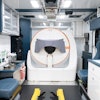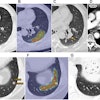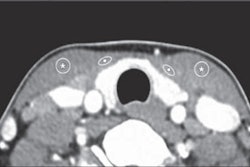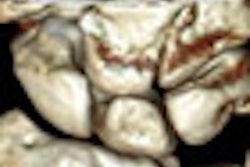Dialysis patients receive more frequent medical imaging exams, particularly CT, and hence more radiation exposure than the population as a whole, putting them at increased risk of developing cancer, according to a new study in the Journal of the American Society of Nephrology.
Of particular concern, the results showed that cumulative radiation doses were highest among younger patients who are more sensitive to the effects of ionizing radiation, wrote Andreana De Mauri, MD; Marco Brambilla, PhD; and colleagues from University Hospital "Maggiore della Carità" (J Am Soc Nephrol, February 25, 2011).
"Patients on hemodialysis require ongoing care that often results in repeated imaging and repeated exposure to ionizing radiation for both diagnostic and therapeutic purposes," De Mauri and her team wrote. "Maintenance hemodialysis, besides being such a chronic condition, is associated with an increased incidence of cancer of unclear etiology."
Radiation exposure adds to the increased incidence of cancer "because of the inherent pathology and must be taken into careful consideration, particularly in younger patients and in those eligible for kidney transplantation," they added.
The investigators followed a group of 106 dialysis patients (63 men) for a median of three years and calculated their radiation exposure -- expressed in cumulative effective dose (CED) -- from hospital records.
The study aimed to quantify radiation dose in the patient cohort, identify subgroups at increased risk, and evaluate the health risks of increased radiation exposure. Over the three-year study period, 23 patients (21.6%) died, whereas six (5.6%) underwent kidney transplantation. Data analysis was halted for each patient at the date of death or transplantation.
The results showed mean and median annual cumulative effective doses of 21.9 and 11.7 mSv per patient-year, respectively. The mean and median total cumulative effective doses per patient received over the study period were 57.7 and 27.3 mSv, respectively.
The patients were classified according to low radiation exposure (n = 22, < 3 mSv per year), moderate exposure (n = 51, 3-20 mSv per year), high exposure (n = 22, 20-50 mSv per year), and very high exposure (n = 11, > 50 mSv per year).
Seventeen patients had a total cumulative effective dose of more than 100 mSv, a value associated with a substantial increase in risk for cancer-related mortality. Of the total radiation dose, 76% was due to CT scanning.
The median number of radiologic procedures was 4.3 (range, 2.3-6.3) per patient-year. CT exams accounted for an outsized 76% of the total cumulative effective dose, but they comprised only 19% of the total number of radiological procedures.
Among the 248 CT procedures, 101 (40.7%) were performed to diagnose a specific disease; for example, in response to symptoms such as neurologic signs, hemorrhage, respiratory distress, trauma, acute pain, suspected cancer, abscess, appendicitis, diverticulitis, suspected aneurysm, or dissection.
A total of 101 CT exams (40.7%) were performed to monitor a previously diagnosed disease, and 46 (18.6%) were for transplant screening. In 96 (38.7%) of the 248 cases, the CT examinations resulted in findings that were judged by the referring physicians as relevant for the patient's clinical management and/or therapy, the study team reported.
On the other hand, in 118 (47.6%) cases, the CT findings did not change patient management, although they showed some abnormalities, and in 34 (13.7%) cases, CT scans produced a negative result.
Younger patients had higher average radiation exposure, and they were also exposed to higher total cumulative effective doses (p = 0.0001) and annual CEDs (p = 0.0002) compared to older patients. Similarly, among the 86 noncancer patients, many of whom were eligible for transplants, both total CED and annual CED were significantly higher in younger (p = 0.0009) versus older (p = 0.0029) patients. The transplant waiting list status was associated with a significantly higher (p = 0.02) annual CED but not total CED.
"This is of particular concern given the anticipated life expectancy of these subjects and the ongoing use of immunosuppressive agents in the latter," De Mauri and colleagues wrote.
The 30 patients on the active transplant waiting list underwent 283 conventional radiology exams, 85 CT scans, 51 nuclear medicine scans, and 27 interventional procedures, including 10 cardiac catheterizations, the authors wrote.
"The most effective way to reduce the population dose from CT is simply to decrease the number of CT studies that are prescribed," De Mauri and colleagues wrote, noting that the retrospective study design didn't allow for firm conclusions about which CT studies might have been avoided.
Total radiologic procedures in 106 patients over three years
|
"As institutions begin to implement radiation reduction and exposure tracking programs, special attention should be paid not only to individuals but also to cohorts, such as the hemodialysis patients in this study," they wrote. "This will also aid in incrementing the awareness of the medical community (including radiologists and emergency room physicians) of the much higher radiation burden associated with CT examinations in comparison with other radiologic procedures."
The study demonstrates that a significant fraction of surviving hemodialysis patients over the course of three years received estimated radiation doses that may put them at an increased risk for cancer, the authors concluded.
"The conservative approach to addressing the issue of cumulative radiation dose necessitates defining groups of patients who would be considered high risk for exposure to ionizing radiation," wrote David Pickens, PhD, and Martin Sandler, MD, from Vanderbilt University School of Medicine in an accompanying editorial (J Am Soc Nephrol, February 25, 2011).
"This group would likely include children because the potential for radiation-induced cancer is more likely over their lifetimes than in older patients," they noted.
When imaging is required, cumulative radiation doses should be monitored carefully and maintained as part of the patients' health record "so that careful considerations of further exposure can be properly documented during the course of treatment," Pickens and Sandler wrote.




















